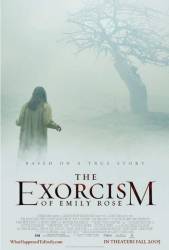Factual error: During the opening scene when the house is being shown, a nest hangs from the porch ceiling with live bees swarming around it. It is also snowing. The insects are honeybees, but the nest is a hornet nest. Honeybees don't make paper nests. Also, bees, hornets, and wasps are not active during the winter. (00:02:40)
Factual error: When Doctor Cartwright is struck and goes through the windshield which shatters like regular glass. Car windshields are laminated and do not break apart and shatter in this manner. (01:32:00)
Factual error: During the credits, as the house is shown, a paper wasp nest is shown hanging from the eaves. Crawling all over it are honeybees, which do not live in paper nests.






Answer: You seem to have missed the point. It boils down to what Emily believed, not anything Ethan manages to explain away. In her written letter the priest reads in court she explains that she believes people would have to believe in God if she showed them the Devil. The logic goes like this: if someone sees or experiences something so horrible that they have to believe the Devil exists, then there has to be a God as well. It's about getting people to embrace faith, which was her ultimate goal. She wasn't concerned with anyone potentially finding evidence to the contrary. She believed that she had to suffer greatly and die in order to achieve the goal, which is the essence of martyrdom. Whether she suffered from mental illness or demonic possession is irrelevant in the end. Emily believed that she did her part to prove God exists when she died and that was all that mattered to her. As for her telling anyone despite her being dead, well, there were witnesses to the attacks and her story was national news. Her story would live on after her death, so in a way she'd be telling anyone that looks into her story.
dewinela